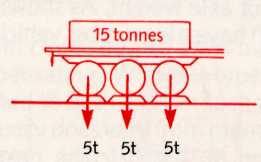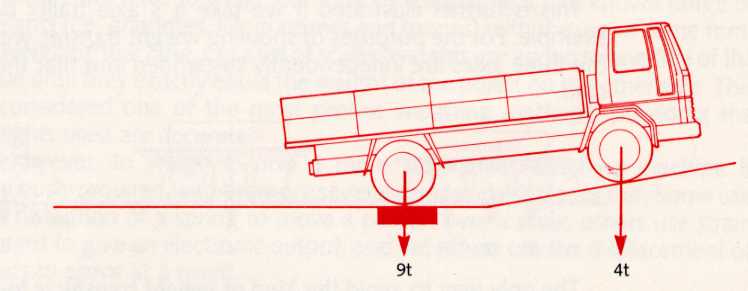This guide provides an objective view of the various types of weighing systems available on the market together with the considerations to be taken into account prior to purchase. A prospective customer of vehicle weighing equipment is well advised to understand these underlying issues before committing to a purchase.
Systems can be categorised into one of the following: –
1.Portable wheel or axle weighers
2.On-board weighing system
3.Single axle weighbridge
4.Full length plate weighbridge
5.Part length weighbridge
1) Portable Wheel Axle Weigher
This is probably the most versatile method of weighing as in theory it should be possible to weigh any wheeled vehicle, anywhere, anytime. However the more axles a vehicles has, the more units one needs to weigh it correctly and the more time it may take to do this. It is also easier to cause weight transfer with this type of equipment. For two axled vehicles, for ‘off site’/’away from base’ weighing, or where the weighing demands are not particularly high, this is probably the most cost-effective method of all.
2) On Board Weighing
The advantage of these systems are that they are installed either as Original Equipment or After Market products, and adds functionality to vehicle information. Increasingly these systems are becoming compatible with Satellite and GPS technology to enable drivers and fleet managers to control the weights of their vehicles. Since these systems are on-board, they cannot give either axle or gross vehicle weights as they can only register weights that are ‘above’ them, although these elements can be easily set. Each vehicle requiring to be weighed has to have a system fitted and this can prove costly for multi-vehicle operations.
With the exception of the two axled vehicles mentioned above, this type of weighbridge provides the easiest and quickest method of obtaining axle weights of all types of road vehicles. Most single axle weighbridges can be operated either statically (stop and go), or dynamically (in motion) which gives the best results when weighing large vehicles with self compensating suspension systems. The most important factor when considering installation of an axle weighbridge is the suitability of the site, which must be firm, flat and level for at least one vehicle length, either side of the weighbridge platform if reasonable results are to obtained. The risk of weight transfer during the weighing will be the determining factor in levels of accuracy, irrespective of the inherent accuracy of the weighbridge.
This type of weighbridge gives the highest levels of accuracy for gross vehicle weights and may be tested and stamped for trade use. Plate weighbridges are usually 15 or 18 metres long with capacities ranging from 50 to 100 tonnes, thus they can accommodate even the largest road vehicle. However they are quite expensive and installation costs can add considerably to the final price. A plate weighbridges can be used to obtain individual axle weights provided it is pit mounted (not surface mounted) and that the roadway adjacent to the weighbridge is firm, flat and level.
These weighbridges are usually 3 or 4 metres long and are most frequently found on farms where they are used to weigh agricultural tractor and trailer combinations. They are essentially a compromise between a full length and an axle weighbridge, and should cost less than the full-length weighbridge. Part length weighbridges can be used to obtain tractor and trailer bogie weights of large articulated trucks and also individual axle weights of other road vehicles provided (as in the case of full weighbridges) that the adjacent roadway is firm, flat and level
Options & Accessories
Many manufacturers of vehicle weighing equipment can design and build systems to meet individual customer’s requirements, or can supply a wide range of accessories with standard products. Such options may comprise special indicators, printers and software packages to enable information to be integrated with access and control equipment, specific software, radio, satellite and GPs systems.
Section 2
Overview of Vehicle Weighing Methods
The weight of an object is defined as its volume multiplied by its Specific Gravity (S.G.). A way of illustrating specific gravity is to consider the difference between a tonne of feathers and a tonne of lead. Both weigh the same, but have vastly different volumes. This is because the specific gravity of a feather is far less than that of lead. The volume and specific gravity of an object such as a cube of wood is easy to calculate as it is a regular shape and is of the same material throughout. Unfortunately, a lorry cannot be thought of as having a regular shape, nor is it made of all the same substance, and therefore it is impossible to mathematically work out its exact weight.
We therefore have to weigh our lorry but comparing it to a known range of weights (i.e. grams, kilograms and tonnes) with the use of some form of weighing machine. On a set of scales, weights are added to one side of the scale until they are exactly the weight of the object on the other side. This is considered on of the most precise weighing methods, providing the weights used are accurate. However, to weigh a lorry, a more substantial weighing machine is obviously required, and there are several devices available for this. Some use the distension of a spring to move a pointer over a scale, others use strain gauges to give an electronic output, and yet others use the displacement of fluids to arrive at a result. The only drawback with all these methods is that their results are relative, comparing the object being weighed with known weights using an indirect means- be it a gauge, dial, scale or electronic output. Therefore it is important to recognise that no weighbridge can ever be totally accurate all of the time. (A simple test is to take a vehicle to several weighbridges under similar conditions of load and fuel and compare results).
Section 3
Consideration of Split Loads and their Effect
There are several methods of split weighing a vehicle, and the finer differences between machines available for weighing a vehicle are covered in a later section. For now, it suffices to say that they will all fall into one or two categories: –
Firstly one should remember that the closer the axles are to each other, the greater the chance of weight transfer and the greater the effects of this transfer of weight.

This is further illustrated if we take a 3-axle trailer bogey as another example. For the purposes of showing weight transfer, we will assume that the three axles are independently suspended and that the trailer chassis is rigid.

The only way to avoid this kind of weight transfer is to raise all the axles simultaneously to the same height above the ground.

2) In the ground machines-i.e. fixed weighbridge installation.

As Illustrated above, where the roadway maintains a constant gradient, the weight transfer is zero to minimal. However weight transfer occurs where the changes in gradient as illustrated below.


To make matters worse, gradients are not the only consideration when thinking about axle weight. As shown below, both vehicles carry the same payload, both have a legal gross vehicle weight and yet one of them is illegal.

Thus we have seen that unless we have a machine that can weight the whole vehicle in one go, there are several important aspects that have to be taken into consideration when split weighing a vehicle in order to achieve an accurate result to avoid prosecution.
Section 4
Consideration Of Operational Issues & Vehicle Fleets
Transport Operation & Vehicle types
As Previously mentioned, where the operator’s business entails constant weighing of vehicles and where the main concern is gross vehicle weight, a full-length plate weighbridge is the best possible method. However, other options to be considered are: –
Type of operation
Distribution, Depot, Haulage, Multiple pick-up or drops, Site work,
Type of vehicle
Twin axle, Multi-axle rigids, Articulated, Articulated with dynamic or self-compensating, suspension
Fleet size
Large/Medium/small
The first general rule is that where there are a relatively large number of vehicles, or where there is a large weighing demand, then a fixed weighbridge will provide the most satisfactory results. The type of weighbridge will depend on whether or not there are vehicles with dynamic or self-compensating suspended axles. If not, then an axle weighbridge is best, otherwise a part length weighbridge is best. The distribution and depot type of operation comes within this category where there are few vehicles or the weighing demand is infrequent, then it should be possible to use portable even if it is a depot or distribution set-up. If the fleet is comprised of two axled vehicles, portable equipment is also quite practical provided the need to weigh is not excessive.
The more axles the vehicle has, the more sense it makes to have an axle weighbridge since the cost will equate with those incurred in having to buy several portables to weigh multi-axles. Where the vehicles are involved in long distance haulage, multiple pick ups/drops or site work (road works, earth moving etc) then portable equipment is the most effective means of weighing. Portables and common-sense can at least allow a driver to spot check his vehicle even if conditions are not optimum and easy access to alternative ways of weighing denied. A pair of portable units with four low cost dummy units would allow even a six axle articulated lorry to be weighed cost effectively. The axles most likely to be overloaded are the drive axle of the tractor unit and the front axle of the tri-axle trailer bogey. If these axles are weighed first and are within tolerance, then it is probable that the other axles are even more complicated, but in all cases, the actual permitted axle weight is the value plated on the vehicle plates. Most Vehicles have a manufacturer’s plate showing the maximum Gross and axle weights for which the vehicle is designed. At the time of registration, the Department of Transport plates vehicles as well. This plate shows the legal gross and axle weights for the vehicle. If there is a difference between the two plates, then the DOT plate prevails. The maximum payload of the vehicle is the plated Gross weight less the unladen weight of the vehicle which is not plated but which also includes fuel, tools, oil, spare wheel, water, driver, spares. Although it is safe to assume that each vehicle is correctly plated, it is not safe to assume that every driver will be aware of axle limits. It is suggested that each vehicle and trailer carries a card in the cab that gives these weights, which act as a visible reminder to the driver of his obligations and responsibilities.
Section 5
Conclusion
- the amount of weighing expected
- the siting of where the weighing will be done
- the type of vehicle to be weighed
- whether it is the axle or the gross weight that is required
With this in mind, there are various additional points worth considering.
Price: There are quite wide variations in price, not all of which relate to variations in performance, but more often to variations in the method of weighing and the various options available.
Maintenance: This is to some extent a function of design and technical complexity, but it is sensible to find out what can go wrong and then find out how much it will cost to put it right. Finally, having pointed all the problems and pitfalls of weighing your vehicles and the penalties if you are found overloaded, a quick note for the authorities. They almost always allow the vehicle some margin for error and it may be as much as 5%. This does not mean you can load your lorry to the legal limit and then add 5% for good measure. It does mean that good weighing equipment, well sited and properly used and maintained, has the levels of accuracy needed to keep you on the road, maximising the loads being carried.
This information is supplied by courtesy of Hawkley International





